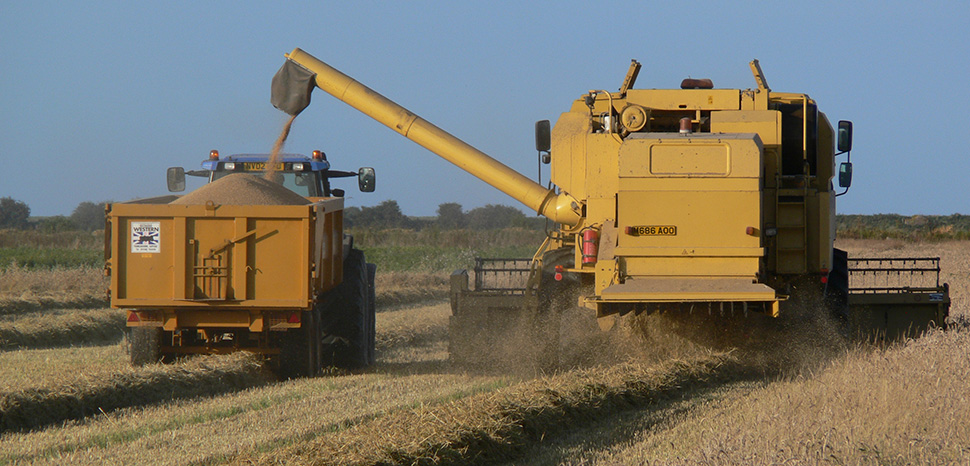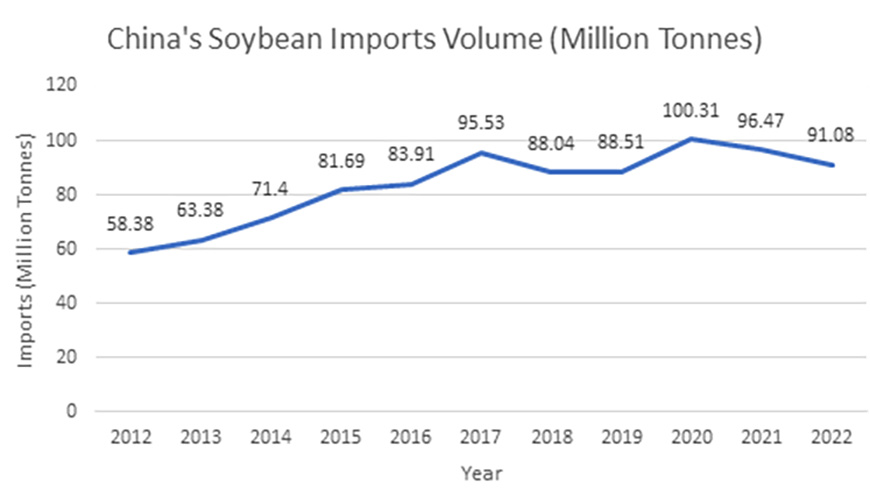Omkar Bhole

The issue of food security has been in the news after Xi Jinping’s recent article on agricultural self-reliance in Qiushi journal, a magazine published by the Central Committee of the Communist Party of China (CPC). In this article, he pointed out that the Russia-Ukraine crisis has demonstrated that agriculture has become a “foundation of national security” and called for food self-sufficiency as one of the top priorities in the coming years. Even the government work report for 2023 has declared stabilization of grain output as one of the top priorities for the government and aims to achieve grain output of over 650 million tonnes (referred to as ‘military order’ by China’s agriculture minister), which has been continuously achieved since 2015 (Figure 1).
However, during the Xi era, China’s per capita output of grains has increased only marginally from 462.5 kg in 2013 to 483.5 kg in 2021. This has resulted in growing dependency on imports during the same period, which, according to Xi, is a national security concern. This dependency has created several vulnerabilities for China which can be exploited in times of crisis. China is currently the largest producer as well as the largest importer of several other food items and thus, China’s food security efforts will inevitably have an impact on the world.

(Figure 1) Source: National Bureau of Statistics
The Extent of Import Dependency
The UN Food and Agriculture Organisation has defined three levels of food self-sufficiency – below 80% as food deficit, between 80%-120% as food self-sufficiency and above 120% as food surplus country. China’s food self-sufficiency rate has decreased from 101.8% in 2000 to 76.8% in 2020 and is further expected to decrease to 65% by 2035 if timely measures are not put in place. Rising import dependency for key food items has largely worsened China’s food security. Loss of cultivable land, less productive seeds, higher costs of domestic production, and food safety concerns of local brands have prompted domestic consumers to opt for imported items. As a result, China has become a net importer of food items since 2004 despite high domestic production.
Currently, China imports more soybean, corn, wheat, rice, and dairy products than any other country, and this dependency has largely increased in the last decade. For instance, the import value of cereals and cereal flour quadrupled from $5.1 billion in 2013 to $20.08 billion in 2021. In terms of volume, imports of cereals and cereal flour have increased fivefold from 13.9 million tonnes in 2012 to 65.4 million tonnes in 2021. Similar trends can be seen in other key food items as well (Figure 2). This import dependency has largely grown since 2018; coterminous with the US-China trade war, which has increased China’s vulnerability to imports. Similarly, China’s corn imports have also grown in the last few years, especially in 2021 when China imported 28.35 million tonnes of corn, an increase of 152% from the previous year. In 2022, China’s corn imports were hit due to the Ukraine war as well as China’s strategy to reduce dependence on the US. This reality also goes against the objective of “ensuring basic self-sufficiency of grain and absolute security of staple food,” as announced by China in its 2019 white paper.

(Figure 2) Source: National Bureau of Statistics
Other than import dependency of food grains, China is also overdependent on imports of seeds, especially in non-staple food. Dubbed the ‘chips of agriculture,’ the seeds industry in China is troubled with low quality, low efficiency, and lack of innovation. Although imported seeds for rice and wheat account for less than 1% of its total seed supply, China is deprived of high-quality imported seeds. Moreover, China’s private sector is very passive in the seeds industry mostly due to their small size, which has limited innovations in the sector. As a result, Chinese companies only control 5% of the global market which is way less compared to Western companies. Although China has managed to procure domestic seeds for major cereals, it still has to rely on foreign seeds for vegetables, corn and maize. Similarly, commercial planting of genetically modified (GM) crops in China has been limited to corn and soybean due to safety issues. Moreover, the US has a dominant position in this sector as it holds nearly 70% of patents in agricultural biotechnology.
The Case of Soybean Imports
Soybean has been an important feed crop for China’s livestock sector and also used as an important oil-crop. Nearly 95% of this soybean is used to produce soy oil for cooking and soybean meal for its huge pork and poultry industry. Pork prices are considered very sensitive as one of the indicators of food inflation which is in turn based on availability of soybean. Thus, China alone accounts for around 60% of global soybean trade. Although domestic soybean production has increased in the last few years to reach 20.28 million tonnes in 2022, China still imports around 82% of its total soybean demand and it is the world’s largest soybean importer. China’s soybean imports have significantly increased from 58.38 million tonnes in 2012 to around 91 million tonnes in 2022, with the highest ever imports in 2020 of over 100 million tonnes (Figure 3). Thus, it became a huge contentious issue during the US-China trade war as the US supplied around $16 billion worth of soybean in 2022, comprising nearly one-third of China’s total soybean imports. The US and Brazil alone account for 90% of China’s soybean imports. Although this dependency has reduced since 2018 owing to the trade war, it is still significant considering China’s limited alternatives.

(Figure 3) Source: National Bureau of Statistics
Domestic Production is Key
China only had around 9% of global arable land (around 2.3 billion mu) by 2019 to feed over 20% of the global population. Thus, new Premier Li Qiang has stressed China’s aim to increase agriculture production by focusing on expansion of arable land. Accordingly, the ‘National land planning (2016-2030) outline’ has proposed to build 1.2 billion mu (197 million acres) of high-quality farmland by 2030 in order to increase domestic production.
In terms of specific products, China aims to increase domestic soybean production by nearly 40% through 2025. However, it faces challenges like low yield per unit area, low comparative benefits of soybean farming, and weak connection between producers and markets. Hence, the Ministry of Agriculture and Rural Affairs recently launched a 10-point programme to promote domestic production of soybean. It includes measures such as increasing subsidies, financial and credit support to soybean producers, promoting intercropping of soybean with corn, strengthening the supply chain of soybean from farms to markets and so on.
China has also focused on expansion of its stockpiling capacity for key food grains. Although food stockpiling is aimed to meet structural shortages, it will invariably have implications for global food security in terms of price rise and shortages. Moreover, to improve seeds quality, China announced expansion of state-sponsored breeding and production centres for seeds. It aims to ensure 80% supply of seeds from these bases by 2025. Similarly, China has begun an overhaul of the GM seed industry to stimulate innovation in this sector. This involves measures like liberalising trial requirements, strengthening safety assessments, and encouraging independent research bases.
US dominance in China’s food imports can prove detrimental for China amid the US-China trade war. Hence, China has reoriented its imports from Brazil, Argentina, and Australia to avoid vulnerabilities from US supplies. As a result, Brazil has become the largest agricultural trade partner of China, accounting for around $45 billion or 20% of China’s agricultural imports in 2021. Similarly, China has also concluded a deal with Australia to restart supply of barley which will reduce its dependence on European countries for barley. Thus, China has been constantly making efforts to reduce its dependency on Western countries which has resulted in its increase in imports from other developing countries.
Conclusion
The realization of economic benefit to common citizens has been the bedrock of CPC’s legitimacy in China. However, failure in ensuring food security can rapidly erode this legitimacy. Such was evident from the Sitong bridge protest a few days before the 20th Party Congress, where protesters demanded food instead of COVID tests. Moreover, the issue also has implications for China’s foreign policy calculations, as evident from China’s soybean dependency on the US being exploited during the trade war. Although China is currently successful in ensuring food security, any disruption in global food supply chain can have serious impact due to higher import dependency. This can also prove to be a vulnerability for China in case of potential Western sanctions amid a China-Taiwan war. Thus, China aims to secure food domestically as much as possible before it takes any radical steps against Taiwan. Whether or not China can achieve this given its limited arable land and other domestic issues, remains to be seen.
No comments:
Post a Comment